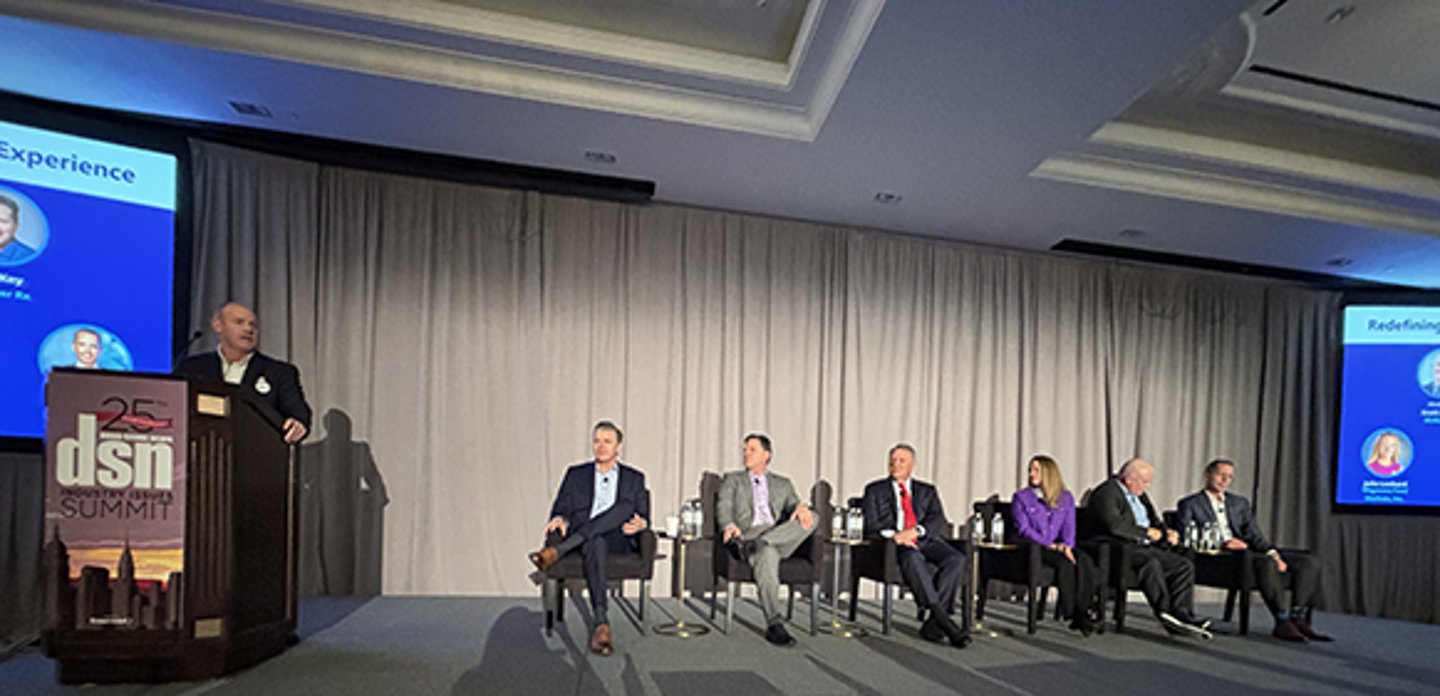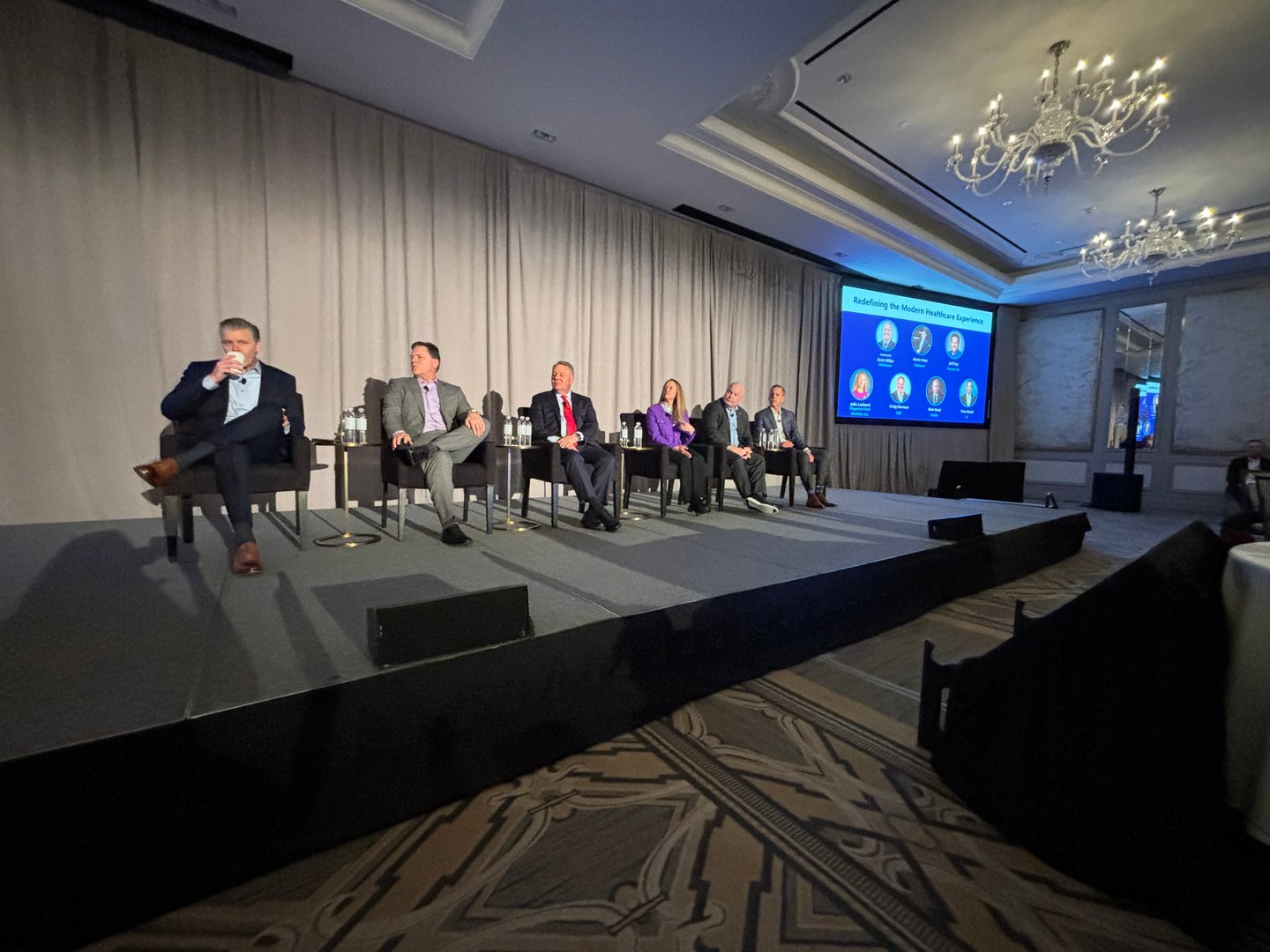How retailers, pharmacy technology companies are redefining the modern healthcare experience
How are retailers and pharmacy technology companies redefining and improving the modern healthcare experience? That was the question posed to executives during the first panel at Drug Store News’ 25th annual Industry Issues Summit.
The panel, “Redefining the Modern Healthcare Experience,” moderated by Scott Miller, president of strategic, community and specialized pharmacy at McKesson, featured top executives from retailers and pharmacy technology companies.
Panelists included Kevin Host, senior vice president of pharmacy at Walmart; Jeff Key, Pioneer Rx president; Julie Lenhard, Wegmans vice president of pharmacy; Craig Norman, H-E-B senior vice president of pharmacy; Dain Rusk, Publix senior vice president; and Tom Utech, iA CEO.
Miller opened the dialogue by asking Host to discuss how Walmart is driving the patient to the right care at the right time and in the right setting. Noting that Walmart has opened 48 clinics in Georgia and Florida and that several more will open in Dallas and Houston next year, Host said, “These clinics are multi-functional, multi-service clinics that will have behavioral health and dental and many will have imaging.”
Host said Walmart is working in partnership with UnitedHealth group and Optum to provide value-based care for patients.
Host cited the company’s immunization offerings that ensures everyone is protected from disease states, such as COVID and RSV. “We’ve also tried to take it a step further. This year we launched in 1,100 pharmacies testing and treatment services provided solely by pharmacists for flu, COVID and strep throat.”
[Read more: Diabetes market faces disruption]
Emphasizing that there’s a severe shortage of primary care physicians, Host said, “Somebody’s got to fill in that gap and when it comes to acute care, upper respiratory conditions like flu, COVID and strep are at the top of that list. About one third of all urgent care visits are for those type of ailments, so If I can get all my pharmacies and pharmacists able to assess, diagnose and prescribe treatments for those, we’ll create access that is much needed.”
Walmart also has created specialty pharmacies of the community around sexual health, HIV care and HIV prevention, and more recently it launched specialty pharmacies focused on autoimmunity. The discussion progressed with Norman describing the care delivery team that includes pharmacists, physicians, nurses, dietitians and physical therapists. Norman said that over the last eight to 10 years, H-E-B has gotten involved in primary care after learning that the majority of its more than 100,000 employees to whom the retailer is providing health care did not have a primary care physician or primary care home, but were using urgent care and ERs.
“We set out a number of years ago with our benefits team to create an outlet for them,” Norman said. “That has now developed into H-E-B Wellness Primary Care. We have a dozen locations, scattered across Austin, San Antonio and the Houston market. They provide all of the services you mentioned, but in addition, we’ve focused most recently over the last few years on mental health counseling and mental health therapists.”
Over the last year, H-E-B began offering a membership program for non H-E-B employees and is partnering with companies to provide this service for their employees.
“This is a non-insured model. It’s cash pay. We have a couple of tiers of memberships, for individuals,” Norman said. “A monthly membership fee starts at $99 and goes to $119 a month, and there’s a number of services included under both of those categories. Our primary care doctors and NPs are spending on average about 30 minutes with each person, so this is truly a personalized health experience for them, and it is really making marked improvements in overall health.”
The discussion proceeded with Utech addressing the potential evolution technology can play to free up pharmacists to practice at the top of their license. “Technology can be an enabler,” Utech said. “Taking that fulfillment activity that typically has been the pharmacists’ duty, and pulling that centrally so it frees up their time. Obviously, COVID pushed a lot more pressure upon pharmacists in providing patient care.
There’s opportunity with technology to centralize more of that fulfillment.” Miller advanced the discussion, asking Lenhard, “We’ve heard about concierge care, where patients can pay a subscription and get a level of guarantee on demand attention and monitoring over a year. Where do you see and what could a retail pharmacy version of concierge look like for you?
[Read more: Retail pharmacy in the age of AI]
“Our personalized customer care program is going to start with a small pilot on a newly diagnosed diabetic,” Lenhard said. “Where we think we can continue to create value for our customers with our pharmacists engaging with them on a regular cadence, first by just assessing their overall health, their access to health, social determinants of health and quality of life measures, really setting up the preferences of our customers and ensuring they are able to interact with our pharmacy services in a way that’s most meaningful for them.”
Lenhard went on to say that Wegmans’ pharmacists can create great connection points with customers based on their disease states. The retailer has been partnering with its nutrition team to help develop health content and webinars for its customers. Wegmans also has wellness keys to help alert customers when shopping what products are vegan, gluten free, lactose free and diabetic friendly. “We’re going to continue to work with Wegmans School of Pharmacy,” Lenhard said. “We see a day where we can be reimbursed and whether that’s with a health plan or employer, certainly we’re going to start similarly to H-E-B with our own employees as well.”
Key weighed in on the future of a subscription model, stating, “We’re becoming a subscription society. We have to define what is going to be the model and that the consumer wants to participate, that they want a subscription service, and they want to talk to someone they can trust. Technology will enable some of those interactions. Everyone should be experimenting, figuring out what those consumers want and what those [subscription] packages are based
on age.”
Scott shifted the discussion to learn how Walmart’s major store remodeling efforts include pharmacy fitting into the shopping experience. Host shared that for the next cohort of 800 stores this year, Walmart is looking at what that wellness room looks like now that it provides testing and treating and long-acting injectable administration.
“Now that pharmacists are being recognized more as providers, now that we’re able to hire additional staff, for i.e., community health workers, we’re able to spend more time with our patients around healthy eating, healthy living,” Host said. “For Walmart, we do A1C screenings and cholesterol screenings in the wellness room. Historically those rooms have been little more than a carve out of a closet. Going forward, we’re looking at multiple wellness rooms, areas for sick people to wait in separately from healthy folks.”
Lastly, Rusk discussed Publix’s model and how the retailer is working successfully with health systems. Rusk said Publix has 11 unique health systems it partners with and will announce a 12th this year.
“When those partnerships started it was more about getting to the patient at bedside, meds to beds delivery,” Rusk said. “From the health system standpoint, they’re trying to improve their scores, trying to maximize their CMS reimbursement that is critical in driving adherence. The worst thing that could happen to a hospital is to discharge someone, and within 30 days they’re
readmitted. It’s very critical that patients leave with those meds, especially patients who may live in a pharmacy desert or who don’t end up having easy access.”
Rusk noted that 56% of people who leave the hospital with a medication in hand didn’t get their prescription from a Publix pharmacy previously. “It’s probably the best loyalty program we have today,” he said. “In Publix pharmacy we end up converting almost 37% of them to come on as Publix shoppers.





